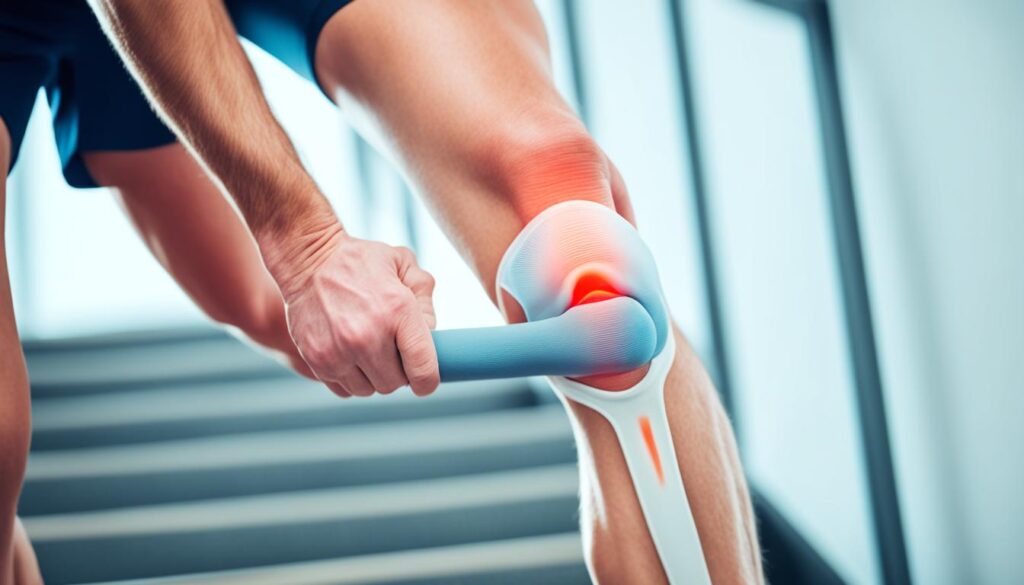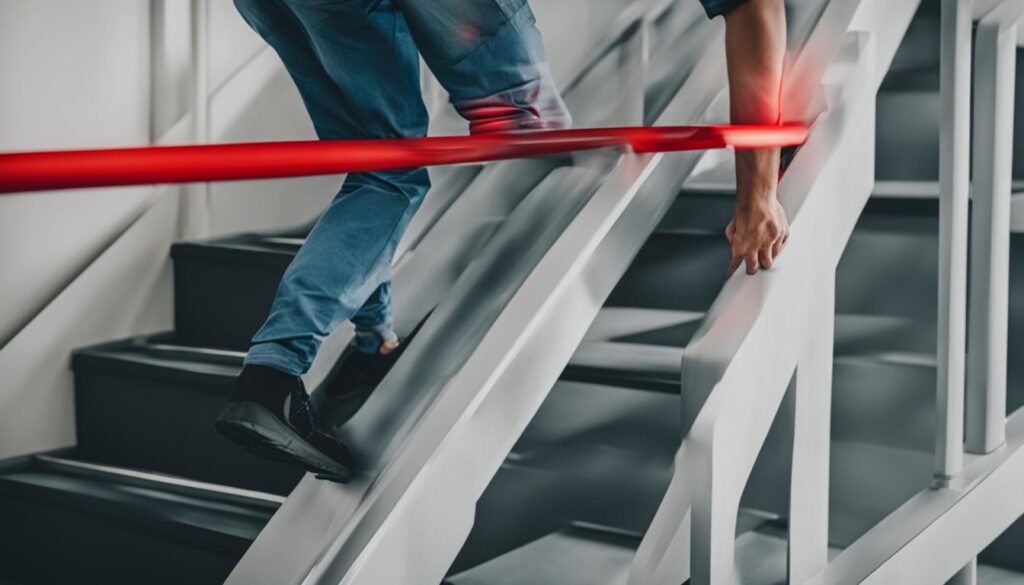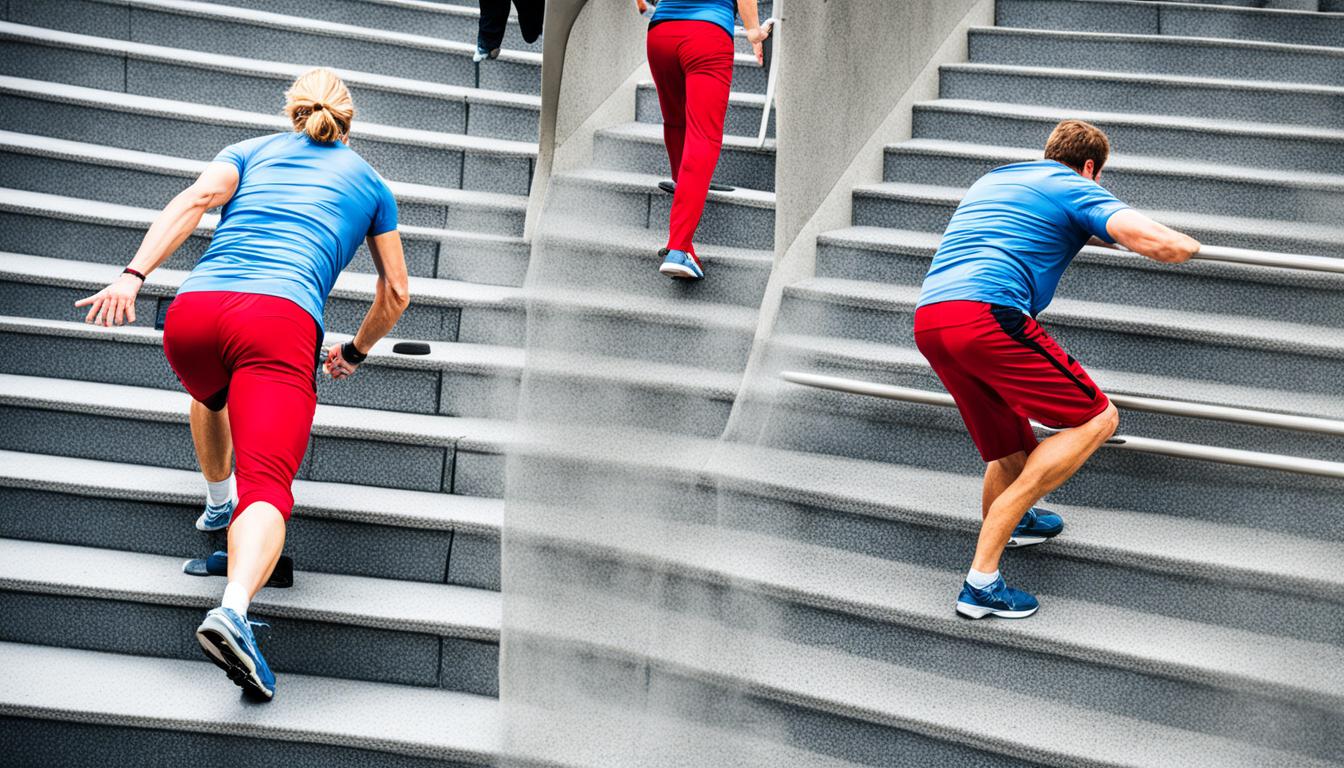If you’ve ever experienced knee pain when walking down stairs, you know how uncomfortable and limiting it can be. Whether it’s a sharp, stabbing pain or a dull ache, knee pain can significantly impact your mobility and quality of life. In this article, we’ll explore the causes of knee pain when descending stairs and provide strategies for finding relief.
Many different types of tissue could be contributing to your knee pain, including bone, ligaments, meniscal tissue, nerve tissue, tendons, or muscle. Identifying the specific part of your knee that is experiencing pain can provide valuable clues as to the underlying cause. It’s also important to note that for some individuals, pain radiating from other areas of the body, such as the lumbar spine or hip, can contribute to knee pain when going downstairs.
One effective way to address knee pain when walking down stairs is through strengthening the muscles surrounding the knee joint. This includes the quadriceps, hamstrings, hip adductors, gluteal muscles, and calf muscles. By addressing any muscle imbalances and improving overall strength, you can alleviate stress on the knee joint and reduce pain. Additionally, stretching, taping, and bracing may be recommended as part of a personalized treatment plan.
In this article, we’ll delve into the common causes of knee pain when descending stairs, discuss the diagnostic process, explore treatment options, and provide practical tips for managing knee pain in your daily life. By understanding the root of your knee pain and implementing appropriate interventions, you can find relief and regain comfort while navigating stairs.
Key Takeaways:
- Knee pain when walking down stairs can be caused by various factors, including tissue damage and referred pain from other areas of the body.
- Strengthening the muscles surrounding the knee joint can help alleviate knee pain and improve overall knee function.
- Common causes of knee pain when descending stairs include patellofemoral pain syndrome, chondromalacia patella, osteoarthritis, and pes anserine bursitis.
- Accurate diagnosis of knee pain when going downstairs often involves physical examinations, imaging tests, and medical history evaluation.
- Treatment options for knee pain when descending stairs range from conservative measures like rest and physical therapy to advanced interventions such as injections or surgery.
Common Causes of Knee Pain When Walking Down Stairs
Knee pain when walking down stairs can have various causes, each requiring a specific approach to diagnosis and treatment. Understanding the common culprits behind this discomfort can help individuals seek appropriate medical attention and find relief. The most prevalent causes of knee pain when descending stairs include:
- Patellofemoral Pain Syndrome (Runner’s Knee): This condition is characterized by pain around or under the kneecap. It can be caused by factors such as weak thigh muscles, tight hamstrings, and poor foot support.
- Chondromalacia Patella: Chondromalacia patella refers to the breakdown and softening of the cartilage on the underside of the kneecap. This can cause pain when the thigh bone and knee rub against each other during stair descent.
- Osteoarthritis: Osteoarthritis is a degenerative condition that affects the knee joint. It can lead to pain and discomfort during weight-bearing activities like walking downstairs.
- Pes Anserine Bursitis: Pes anserine bursitis occurs when the fluid-filled sac on the inside of the knee becomes inflamed and swollen. This can result in knee pain while going up or down stairs.
Identifying the specific cause of knee pain when walking down stairs is essential for developing an effective treatment plan. It is recommended to consult with a healthcare professional for a comprehensive evaluation and personalized recommendations.

Diagnosing Knee Pain When Walking Down Stairs
To accurately diagnose the cause of knee pain when walking down stairs, healthcare providers may administer several tests:
- Physical examination: This involves assessing the tenderness or swelling in the knee, as well as evaluating range of motion and muscle strength.
- Blood tests: These tests can help determine the presence of any underlying conditions or markers of inflammation.
- X-rays: This imaging technique provides detailed images of the bones in the knee joint, helping identify any structural abnormalities or signs of degeneration.
- MRI scans: Magnetic resonance imaging can provide a more comprehensive view of the knee joint, including the soft tissues like ligaments, tendons, and cartilage. This can be particularly useful in diagnosing conditions such as patellofemoral pain syndrome, chondromalacia patella, or pes anserine bursitis.
By conducting these tests, healthcare providers can gather necessary information to determine the underlying cause of knee pain when walking down stairs, whether it is related to patellofemoral pain syndrome, chondromalacia patella, osteoarthritis, pes anserine bursitis, or other factors.
With a comprehensive diagnosis, healthcare providers can develop an individualized treatment plan to address the specific cause of knee pain and improve function.

“Accurately diagnosing knee pain when descending stairs is crucial in effectively addressing the underlying cause and providing relief.”
Treating Knee Pain When Walking Down Stairs
The treatment for knee pain when walking down stairs depends on the underlying cause and severity of the condition. Our goal is to alleviate your discomfort and improve your quality of life. Our treatment options are tailored to address the specific needs of each individual.
Conservative Treatments
If you’re experiencing knee pain when walking downstairs, conservative treatments can often provide relief. These include:
- Rest: Allowing your knee to rest can help reduce inflammation and promote healing.
- Ice: Applying ice to the affected area can help alleviate pain and reduce swelling.
- Compression: Using a compression bandage or knee brace can provide support and help manage inflammation.
- Elevation: Elevating your leg can help reduce swelling and improve blood circulation.
- Nonsteroidal Anti-Inflammatory Drugs (NSAIDs): Over-the-counter medications like ibuprofen can help reduce pain and inflammation.
- Physical Therapy: Engaging in targeted exercises can strengthen the muscles surrounding the knee joint, improve flexibility, and decrease pain during stair descent.
- Weight Loss: If excess weight is contributing to your knee pain, losing weight can help alleviate the pressure on your joints.
Advanced Interventions
In some cases, advanced interventions may be necessary to address the underlying cause of your knee pain when walking downstairs. These interventions include:
- Corticosteroid Injections: Injecting corticosteroids directly into the knee joint can provide temporary pain relief and reduce inflammation.
- Surgical Procedures: If conservative treatments have been unsuccessful, surgical procedures may be recommended. These can involve repairing damaged ligaments, removing loose bodies, or realigning the knee joint.
It’s important to consult with a healthcare professional to receive an accurate diagnosis and develop an individualized treatment plan. They can guide you through the available options and recommend the most suitable course of action. Don’t let knee pain limit your ability to walk downstairs comfortably. Take steps to address your condition and improve your mobility.
Tips for Managing Knee Pain When Walking Down Stairs
Managing knee pain when walking down stairs can greatly improve your daily life. Incorporating the following strategies into your routine can provide relief and help you regain comfort:
- Lead with the whole foot: When stepping onto the stairs, make sure to place your entire foot on the step. This helps distribute the pressure evenly and reduces strain on the kneecap.
- Activate the gluteus muscles: Push off from the outer heel of your foot when ascending or descending stairs. This activates the gluteal muscles, which can help decrease strain on the knee.
- Choose proper footwear: Wearing shoes that provide adequate support can make a significant difference in managing knee pain. Look for shoes with good cushioning and stability to alleviate stress on the knee joints.
Additionally, strengthening the muscles surrounding the knee through targeted exercises can improve overall knee function and provide relief. Focus on exercises that target the quadriceps, hamstrings, hip adductors, gluteal muscles, and calf muscles. Regular stretching and mobility exercises can also help reduce stiffness and improve flexibility in the knee joint.
Listening to your body is essential. Avoid activities that exacerbate the pain and consult with a healthcare professional for personalized recommendations. They can offer guidance based on your specific condition and provide additional strategies to manage knee discomfort when walking downstairs.
| Strategies for Managing Knee Pain When Walking Down Stairs | Benefits |
|---|---|
| Leading with the whole foot | Reduces pressure on the kneecap |
| Activating the gluteus muscles | Decreases strain on the knee |
| Choosing proper footwear | Provides adequate support |
| Strengthening surrounding muscles | Improves knee function |
| Stretching and mobility exercises | Reduces stiffness and enhances flexibility |
Implementing these tips, in conjunction with the guidance of a healthcare professional, can significantly alleviate knee pain when descending stairs and enhance your overall mobility.
Conclusion
Knee pain when walking down stairs can have a significant impact on daily activities and overall quality of life. It is crucial to understand the underlying causes of this pain and seek appropriate medical evaluation and treatment to alleviate symptoms and improve function.
By implementing lifestyle modifications and engaging in targeted exercises, individuals can effectively manage knee pain and regain comfort while walking down stairs. It is essential to follow the guidance of healthcare professionals and develop a personalized treatment plan tailored to specific needs.
If you are experiencing knee pain when descending stairs, remember to consult with a healthcare professional for an accurate diagnosis and comprehensive treatment options. With the right approach, it is possible to overcome knee discomfort and restore mobility to enjoy an active and pain-free lifestyle.
FAQ
What are the most common causes of knee pain when walking down stairs?
The most common causes of knee pain when walking down stairs include patellofemoral pain syndrome (runner’s knee), chondromalacia patella, osteoarthritis, and pes anserine bursitis.
How can I manage knee pain when walking down stairs?
Strategies for managing knee pain when walking down stairs include leading with the whole foot, activating the gluteus muscles, ensuring proper footwear, and strengthening the surrounding muscles through targeted exercises.
What exercises can help strengthen the muscles around the knee joint?
Exercises that can help strengthen the muscles around the knee joint include quadriceps exercises, hamstring exercises, hip adductor exercises, gluteal muscle exercises, and calf muscle exercises.
When should I seek medical evaluation for knee pain when walking down stairs?
It is advisable to seek medical evaluation for knee pain when walking down stairs if the pain persists, worsens, or if there are signs of swelling, redness, or instability in the knee joint.
What can healthcare providers do to diagnose the cause of knee pain when walking down stairs?
Healthcare providers may administer several tests, including a physical examination, blood tests, X-rays, and MRI scans, to accurately diagnose the cause of knee pain when descending stairs.

Leave a Reply